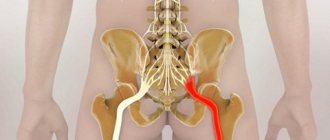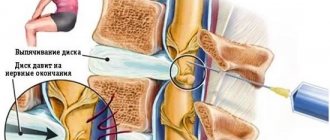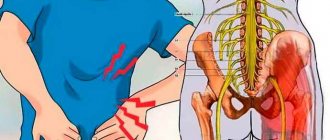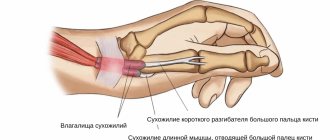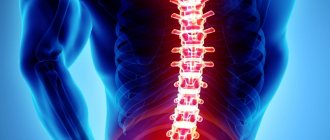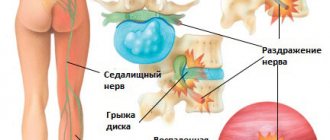Lower back pain radiating to the leg is a serious reason to consult a doctor. Do not tolerate neuralgia: it requires treatment, like any other disease.
Unfortunately, services for the treatment of lumbar nerve entrapment have been suspended. Familiarize yourself with the symptoms of the disease and contact your doctor.
A pinched nerve of the lumbar spine is compression of nerve endings by spasmed muscles, displaced vertebrae or a hernia. Accompanied by attacks of acute pain and impaired mobility of the patient. How dangerous is this condition and how to treat it?
Pinched lumbar nerve is observed in patients after 30 years of age and brings a lot of trouble, as it directly affects a person’s quality of life and performance.
Causes of the disease
At the level of the thoracic part of the spine, nerves emerge from the spinal cord symmetrically on both sides, following under each rib. They innervate the skin and muscles of the corresponding area, and have connections with nerves going to the internal organs.
Osteochondrosis is the most common cause of a pinched nerve in the chest. With this disease, the height of the intervertebral discs decreases, and the shock-absorbing properties of the cartilage are lost. There are often bone deformities that increase pressure on the nerve. Often the disease develops against the background of scoliosis – a sideways curvature of the spine.
Diabetes mellitus, atherosclerosis, arterial hypertension, chronic renal and endocrine diseases, age-related changes lead to damage to blood vessels and nerves. This also worsens the working conditions of the muscles, ligaments, discs, and joints of the spine.
Prolonged stay in a forced position, heavy lifting, uneven load on the back (carrying a heavy bag in one hand) provoke the appearance of pain. A pinched nerve in the thoracic region can be on the left, right, or both sides.
Symptoms
Among the characteristic symptoms of a pinched nerve in the lower back are impaired sensitivity of the skin in the affected area, dysfunction of adjacent internal organs, numbness of the back muscles and limited movement. The pain itself can be of a different nature: sharp, aching, spasmodic or constant.
Regarding the localization of pain in medical practice, it is customary to distinguish the following conditions:
- Lumbagia is pain in the lumbar back.
- Ishalgia is a lesion of the sacral vertebrae. Sometimes neuralgia is observed in the lower extremities and gluteal muscles.
- Lumboischalgia - lower back pain innervating the back of the legs.
Separately, I would like to say about sciatica, since pinching the nerve of the lumbosacral region is the most painful: it brings with it a burning sensation, tingling, neuralgia of the lower extremities, and a decrease in their motor functions.
Clinical manifestations
A pinched nerve in the thoracic spine is accompanied by the following symptoms:
- Pain in the back, chest, which spreads between the ribs. It can radiate to the lower back, under the shoulder blade, or into the arm. It happens in the form of attacks, very strong, burning, stabbing or barely noticeable, aching, but is constantly present. The pain intensifies with movement, breathing, coughing, sneezing. Sometimes it is difficult for a person to raise his arms or bend over.
- Loss of sensitivity along the nerve. A person may feel numbness, a crawling sensation, or, conversely, hyperesthesia, that is, increased sensitivity of the skin. Any touch then causes discomfort or pain.
- Considering that movements are accompanied by pain, breathing becomes shallow, which can further lead to problems with the respiratory system.
- Severe constant pain exhausts a person, leads to fatigue, irritability, and a general decrease in tone and immunity.
Symptoms
- Start
If there is a disturbance as a result of compression of the blood flow in the artery supplying the nerves, which most often occurs in the area of the 4th and 5th lumbar vertebrae, symptoms of pinching appear gradually over a period of time. Pain and changes in sensitivity occur; with movement the symptoms intensify, with rest they decrease, and with a certain posture they disappear altogether.The level of nerve compression determines the clinical manifestations; if an intervertebral disc herniation or osteophyte during osteochondrosis occurs between the 4th and 5th lumbar vertebrae, then the back and lateral surface of the thigh, shin and heel become numb; if between 3 and 4, numbness occurs at the level of the knee, between 3 and 4 2 – buttock goes numb.
- Development of a pathological condition
Gradually, several roots feeding from the compressed artery are involved in the pathological process, pain in the lower back intensifies and the area of sensitivity disturbances increases, the legs become weak, the skin in some anatomical areas innervated by the affected root becomes numb. When walking, the leg may bend at the knee, get tired quickly, and lameness appears, but when the posture changes, all these signs of a pinched nerve in the lower back go away. The feet become numb, the numbness can spread to the genitals, and be accompanied by urination problems. These are clinical manifestations of compression syndrome.
- Exacerbation
When the nerve root itself is compressed, symptoms appear acutely in the form of a lumbago in the lower back, the pain radiates to the genitals or to the leg, preventing the person from moving. Because of the pain, he freezes in an unnatural position “with a stake” in the spine.
Lumbago is manifested by motor disturbances, up to paresis; changes in sensitivity are noted in the skin innervated by the affected root: numbness or distortion, when touch is felt as pain - paresthesia.
- Chronic condition
Chronic radicular syndrome - lumbodynia is marked by constant transient aching painful sensations or a feeling of heaviness in an uncomfortable position, sometimes a lumbago occurs with exertion or movement. Exacerbations can develop acutely with physical exertion, or increase over several days with hypothermia.
Our expert in this field:
Vasinkina Inna Yurievna
Neurologist
Call the doctor Reviews about the doctor
Diagnostics
A tightness in the chest on the left is often disguised as heart disease. Some people mistake the acute pain for an angina attack or even a heart attack, given the intensity of the pain. A doctor can distinguish these diseases by conducting an examination, including an ECG, echocardiography, and blood tests. It is characteristic that the pain that occurs when a nerve is pinched in the thoracic spine on the left is not relieved by cardiac medications (validol, nitroglycerin).
Often the pain radiates to the epigastric region, hypochondrium, and lower back. Then diseases of the stomach, intestines, liver, and kidneys should be excluded.
The osteopath conducts a detailed survey of the patient and palpates points along the spine. When a nerve is pinched in the thoracic spine, it is these zones (1.5 cm to the side of the spinal column) that are characterized by maximum pain. Because this is where the nerve exits under the skin.
X-ray methods help to identify abnormalities in the structure of the spine. The most accurate additional study for pathology of soft tissues is MRI, bones - CT. A consultation with a neurologist is required. He diagnoses at what level the nerve is pinched in the thoracic region and prescribes treatment.
Causes of a pinched nerve in the lower back
Pinching of the lumbar nerve can occur as a result of progressive intervertebral hernia and osteochondrosis - common diseases of the musculoskeletal system. Predisposing factors to the development of these conditions may be:
- excessive physical activity;
- lifting weights;
- hormonal imbalance;
- diseases of the endocrine system;
- overweight;
- old age.
A pinched nerve in the lower back also appears as a result of neoplasms. When the first symptoms of compression neuralgia appear, it is necessary to seek medical help as soon as possible, since the absence of treatment can lead to the development of paralysis of the lower extremities.
Treatment of a pinched lumbar nerve
Adequate treatment of the disease largely depends on correct diagnosis. Conservative and surgical treatment are possible.
The first group consists of physiotherapeutic, manual procedures and drug treatment. During treatment for a pinched nerve in the lower back, the patient is advised to rest in bed on a hard surface that provides better nutrition to the spine. The most effective physiotherapy techniques are:
- electrophoresis;
- UHF drugs;
- ultrasound therapy;
- magnetic therapy;
- massotherapy;
- acupuncture.
Unfortunately, services for the treatment of lumbar nerve entrapment have been suspended. Familiarize yourself with the symptoms of the disease and contact your doctor.
Cosmetic procedures are contraindicated during pregnancy and lactation.
Principles of treatment
Pain relief is aimed at reducing pain and eliminating muscle spasms in the affected area. If taking NSAIDs orally or by injection does not help, blockades are performed. This is the introduction of drugs into the most painful points, which are projections of the exit of nerves. Local anesthetics, hormones, NSAIDs, and muscle relaxants are used. Diuretics reduce swelling of the compressed nerve and eliminate pain. Drugs are prescribed that improve the conductivity of nerve tissue.
In addition to relieving acute pain, it is necessary to influence the cause of pinching of the intercostal nerve in the thoracic region. Medicines, massages, manual therapy, physiotherapeutic procedures, reflexology, and physical therapy help reduce the destruction of bones and joints. Medicines prescribed:
- vascular drugs - improve blood circulation;
- chondroprotectors – restore the properties of the cartilage layer between the vertebrae;
- calcium supplements, vitamin D fight osteoporosis;
- multivitamin complexes with minerals.
Acupressure, lymphatic drainage and classic types of massage are used. The impact on the back muscles helps eliminate spasms, improves blood flow and tissue nutrition. Thanks to this, it is possible to break the pathological circle, when pain causes muscle contraction, which compresses nerve fibers and blood vessels, disrupting blood supply and increasing pain.
In some cases, surgical treatments may even be necessary. For example, to eliminate the consequences of an injury, remove a significant hernia, tumor, or perform spinal stabilization.
Every person should be attentive to their health and not ignore the symptoms of a pinched nerve in the thoracic region if they appear. It is important to seek qualified help immediately. After all, the earlier the problem is identified, the greater the chances of achieving complete restoration of the function of the nerves and all structures of the spinal column, and of avoiding another pinching under the breast in the future.
Treatment tactics
The level of nerve pinching in the lower back and the severity of symptoms determine treatment tactics. First of all, pain is relieved, in severe cases using drug blockades. If radicular syndrome in the lower back is accompanied by progressive impairment of motor functions, then urgent surgical decompression may be required - relief from the pressure of the herniated intervertebral disc.
After stopping the acute process, physiotherapeutic treatment of osteochondrosis, spinal traction, massage and physical therapy are carried out.
At the Medica24 neurological international clinic, an individual approach is applied to each patient based on clinical recommendations from the world's leading medical centers, which allows for optimal results to be achieved in a short time.
What is the cause of a pinched nerve?
There are no definitive signs of a pinched nerve in the back. Although acute pain in this area is almost always associated with nerves. If muscles hurt, then the nature of the pain is different. In this case, it is constant, aching, weaker.
A definite diagnosis can be made with the help of X-rays and MRI, but one can make assumptions based on the type of painful sensations.
If the lower back hurts due to a pinched nerve, then this is lumbagia. There is an option that the sacral area will hurt, moving to the back of the leg - this is ischalgia. A combined case is possible (when it hurts in both the first and second places) - this is lumbar ischialgia.
The feeling of burning and numbness is caused by pinched nerves.
In 90% of cases, the cause of a pinched nerve is improper muscle function. There are muscle tissues near the nerves that can spasm from overexertion and stop working adequately. If this continues for years (and this is inevitable during sedentary work), then the spasmed muscle either forms a protrusion or intervertebral hernia (and they already pinch the nerve), or the muscle itself begins to compress the nerve. Muscle spasm is caused by prolonged sitting, stress, and a sedentary lifestyle. and excess weight.
If you already have muscle problems, then any awkward movement or overload can cause severe pain. Under unfavorable conditions, the spasmed muscle tenses more strongly and sharply compresses the nerve in the lower back or the sciatic nerve (most often compressed by the muscles). Severe pain occurs immediately. The person rested, the muscle relaxed a little, and the severe pain went away. It may be that a person feels good in the morning, but in the evening pain begins to appear in the lower back. This means that the spasm increases, and the muscle pinches the nerve more strongly.
If left untreated, this will happen again and again, and the severity and duration of the pain will increase.
